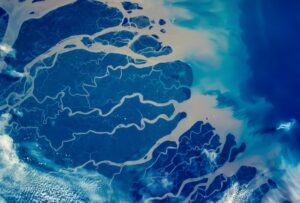Deep in a mine in Canada, an unassuming pool of water is the most ancient source of water on Earth.
Initially, scientists believed that a gold-uranium mine in South Africa had the world’s oldest water. This water was tens of millions of years old and contained a “Pandora’s box of helium and hydrogen,” according to Oliver Warr with the University of Toronto, as well as radiogenic neon, argon, helium, and xenon.
However, scientists have found water that is a lot older. The water trapped in Ontario’s Kidd Creek Mine is more than 2 billion years old!
Characteristics
This ancient pool of water might not be the safest choice for a drink. Barbara Sherwood Lollar, a geoscientist at the University of Toronto, actually tasted it. Lollar said it was “terrible” and had a sulphuric smell. If you were to drink it, it might overload your immune system or even put it into shock.
The water is 10 times saltier than seawater and is viscous like syrup. On contact with oxygen, it changes from clear to a faint orange, most likely from the iron in the surrounding rock. According to Lollar, the older the water, the saltier it becomes.
At three kilometers deep, the Kidd Creek Mine is the deepest basal metal mine in the world. It has massive deposits of silver, copper, and zinc. Undoubtedly, these metals interacted with these very old deposits of water deprived of oxygen, creating a toxic pool with a highly complex chemical composition.
The water contains inert gases such as xenon, helium, krypton, neon, and argon, much like its South African counterpart. Surprisingly, it also houses living bacteria or microbes.
Lollar states that the sulfates provide a “fingerprint that [indicates] the presence of life.” These microbes survived on sulfates and hydrogen. Scientists have only previously recorded these microbes on the ocean floor. This suggests that the pool was once a part of an ancient ocean. The water’s temperature averages 25°C.

Water from Kidd Creek Mine. Photo: Ingenium
2.6 billion years old
In an interview with The Los Angeles Times, Lollar explained that the “rocks formed about 2.6 billion years ago on what was an ancient ocean floor. Some of the water trapped in them could be remnants of ocean water that was in contact with the rock when it was formed, and some of the water probably moved through the cracks in the rock and got stuck there.”
Therefore, it is possible that other mines in the world hold similarly ancient pools.
Finding out the water’s age required a series of tests over four years. First, scientists analyzed the water for inert gases. Next, they sent samples to the University of Oxford. Here, a mass spectrometer calculated the gas ratios and radiogenic isotopes in the water. The age of the water was startling.
The water’s sulfur content was important, too. The interaction between the water and the surrounding rock created sulfates. The water stimulated the oxidation of sulfide minerals in the ore. When the water is exposed to oxygen, it started to form sediments. This disproved their original hypothesis that the sulfates originated from surface water flowing underground.

A scientist collecting a sample. Photo: University of Toronto
Why is this important?
Not only does this give us insight into life deep underground but also above. The fluid’s astonishing age suggests that ancient water, and therefore life, may also occur on other planets, especially Mars. According to Lollar, the data collected could also tell our planet’s story: how water and life came into being.






